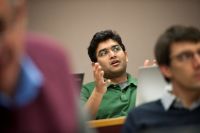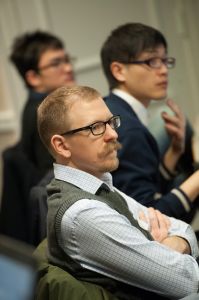As more than 30 experts from around the world gathered at the Brain Simulation Workshop, we sat down with a group of young researchers to discuss the work needed to broaden the areas of the brain that can be treated with focused ultrasound.
 Currently, the technology is able to effectively focus ultrasound beams on regions in or near the thalamus for treating movement disorders. “It is typical in developing applications for a new technology to start with a relatively straightforward and simple approach. Then more careful studies and modeling are undertaken to elucidate mechanisms, refine the technology, and improve outcomes,” said Wayne Kreider, Senior Engineer, Applied Physics Laboratory, University of Washington.
Currently, the technology is able to effectively focus ultrasound beams on regions in or near the thalamus for treating movement disorders. “It is typical in developing applications for a new technology to start with a relatively straightforward and simple approach. Then more careful studies and modeling are undertaken to elucidate mechanisms, refine the technology, and improve outcomes,” said Wayne Kreider, Senior Engineer, Applied Physics Laboratory, University of Washington.
The opportunity now lies in expanding the currently treatable region to investigate and remedy neurological disorders. We are at a tipping point in which the targeting and temperature elevation are at its maximum limit, and the workshop was convened to share ideas on how to overcome these challenges. Experts discussed ways to create accurate simulations that would extend the focal region, facilitate patient selection, and predict and prevent unwanted secondary effects like skull heating.
 The workshop has served as fertile ground for clinicians and scientists to confer. “We are advancing ultrasound modeling, and being able to talk with clinicians and to hear about their clinical goals and interests provides us really useful feedback to ensure that our work will help meet their needs,” said Bradley Treeby, Early Career Fellow, Department of Medical Physics and Biomedical Engineering, University College London.
The workshop has served as fertile ground for clinicians and scientists to confer. “We are advancing ultrasound modeling, and being able to talk with clinicians and to hear about their clinical goals and interests provides us really useful feedback to ensure that our work will help meet their needs,” said Bradley Treeby, Early Career Fellow, Department of Medical Physics and Biomedical Engineering, University College London.
Researchers are working to create tools to model, or simulate, delivering varying levels of ultrasound energy to different targets in the brain. “The goal is to go beyond physics by identifying potential interaction mechanisms and establishing dose-effect relationships. Ultimately, investigators will need to demonstrate they can predict, with known precision, quantities of interest of a complex reality based on increasingly sophisticated simulations,” remarked Esra Neufeld, Head Computational Life Sciences Group at the IT’IS Foundation in Zurich.
“I’m also excited about the potential of simulation and modeling to assess the treatment envelope and efficacy of focused ultrasound for non-ablative applications like localized drug delivery and neuromodulation,” shared Raag Airan, MD, resident physician in diagnostic radiology at Johns Hopkins Hospital. He added, “I know about the clinical constraints, but we are lacking measurement capability. Being in contact with people who have devices and measurement tools to reproduce and benchmark decisions is invaluable. The richness of ideas and small size of this forum are extremely effective.”
